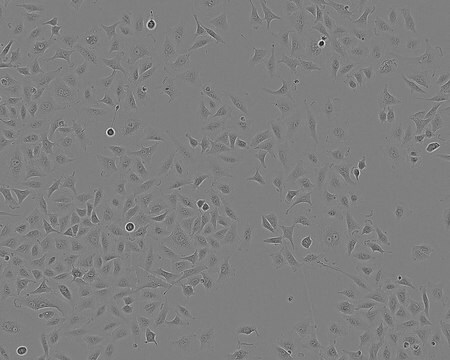JU77 cell line human
10092309, human lung, epithelioid: spindly with few vacuoles. Cobblestone morphology at confluency.
Sign Into View Organizational & Contract Pricing
All Photos(1)
About This Item
UNSPSC Code:
41106514
Recommended Products
product name
JU77 cell line human, 10092309
biological source
human lung
description
Malignant mesothelioma cells from human lung
growth mode
Adherent
karyotype
Not specified
morphology
Epithelial-like: cells are spindle-shaped with few vacuoles. Upon confluence develop an epithelioid "cobblestone-like mat"
products
Not specified
receptors
Not specified
technique(s)
cell culture | mammalian: suitable
relevant disease(s)
cancer
shipped in
dry ice
storage temp.
−196°C
Cell Line Origin
Human malignant mesothelioma
Cell Line Description
This cell line was derived from the pleural fluid of a patient with malignant mesothelioma. The patient had known exposure to crocidolite asbestos. JU77 is not tumourigenic in nude mice. Cells express cytokeratin and epithelial membrane antigen (EMA) but not mucin. Cells are spindle shaped with few vacuoles. Cell Bank Australia reference number: CBA0140
Application
Investigation of the properties of malignant mesothelioma cells and the development of new diagnostic methods.
Culture Medium
RPMI 1640 (with 2mM L-Glutamine+ 25mM HEPES) + 5% FCS
Subculture Routine
Optimal split ratio 1:8 (seeding density 0.8 x104 cells/cm2).Cells incubated at 37°C with 5% CO2.Harvest the cells using 0.05% Trypsin/EDTA at 37°C for 5 min.
Other Notes
Additional freight & handling charges may be applicable for Asia-Pacific shipments. Please check with your local Customer Service representative for more information.
Cultures from HPA Culture Collections and supplied by Sigma are for research purposes only. Enquiries regarding the commercial use of a cell line are referred to the depositor of the cell line. Some cell lines have additional special release conditions such as the requirement for a material transfer agreement to be completed by the potential recipient prior to the supply of the cell line. Please view the Terms & Conditions of Supply for more information.
Depositor and originator: Richard Lake - University of Western Australia, Australia
Certificates of Analysis (COA)
Search for Certificates of Analysis (COA) by entering the products Lot/Batch Number. Lot and Batch Numbers can be found on a product’s label following the words ‘Lot’ or ‘Batch’.
Already Own This Product?
Find documentation for the products that you have recently purchased in the Document Library.
Our team of scientists has experience in all areas of research including Life Science, Material Science, Chemical Synthesis, Chromatography, Analytical and many others.
Contact Technical Service
